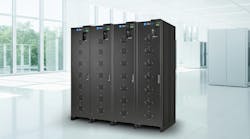In the Age of Data Centers, Our Connected Future Still Needs Edge Computing
With the rise of artificial intelligence (AI) and machine learning (ML), the expansion of data centers in both physical footprint and capacity has been a hot topic. Equipping data centers to meet the cooling and power requirements of next-generation IT is one of the key technological challenges of our time. Liquid cooling has become a leading technological enabler of this AI transformation. However, amidst all the focus on large data centers and high-performance chips, another critical technology is becoming increasingly essential to our electrified and digitalized future: edge computing.
Edge computing refers to a distributed computing network that processes data closer to its source, such as local edge servers or Internet of Things (IoT) devices. This approach uses smaller, networked devices like computers, mobile phones, industrial controls and embedded devices. By processing data near its origin, edge computing provides faster insights, greater bandwidth availability and improved response times compared to sending data to a centralized cloud data center.
These incremental improvements in speed are crucial for applications like autonomous vehicles, smart city infrastructure, manufacturing automation and telecom applications such as 5G network deployment. In these contexts, quick and reliable data processing can be the difference between success and failure.
Even as data center technology evolves, edge computing will continue to play a pivotal role in our future. The technological advancements made for large data centers can also be applied to edge computing, offering significant benefits in speed, performance and safety. In recent years, edge computing technology has made substantial strides forward. With billions of connected devices worldwide and the edge computing market projected to exceed $300 billion by 2026, reliance on edge devices for essential processes at work and home is set to grow. So, how do we ensure these critical computing applications remain powered and protected?
Remote Applications Bring Unique Challenges
One of the biggest challenges for edge computing is the protection of data and equipment. Because edge equipment is often located in environments where it is needed most, harsh conditions frequently come with the territory. In industrial applications, equipment must be protected from high heat and vibrations. In 5G or utility applications, equipment is often exposed to elements such as wind, rain, heat, cold and sand.
Cooling edge computing equipment also presents challenges. The data solutions industry has developed many innovative cooling solutions for large data centers, where controlled environments allow for highly efficient cooling. Engineers are now adapting these technologies for edge applications, including advanced air and liquid cooling methods, which are more suitable for edge environments.
Managing Decentralized Edge Compute Nodes
The decentralized nature of edge compute nodes brings both advantages and challenges. Unlike centralized data centers, edge compute nodes are distributed across various locations closer to the data sources. This enhances processing speed, reduces latency and allows for real-time decision-making, crucial for applications like industrial automation, autonomous vehicles, and telecom.
However, managing these dispersed nodes introduces complexity. Ensuring consistent performance across diverse and often harsh environments demands robust protective measures, efficient cooling solutions, reliable security protocols, and comprehensive remote monitoring systems. Each node must handle potential cyber threats and maintain data integrity while operating independently in scenarios with limited connectivity. The logistical effort to install, monitor and maintain these nodes seamlessly within a cohesive network requires advanced management strategies. Integrated solutions that offer easy remote management capabilities are essential, enabling administrators to monitor, control and update edge devices remotely, ensuring they remain secure, efficient, and reliable across all locations.
Choosing Solutions for Security and Protection
When choosing solutions to protect critical edge computing infrastructure, it is crucial to consider the environment and focus on maximizing uptime. Look for enclosures that offer easy access for technicians and are rated to withstand harsh conditions such as corrosive, wet, windy or cold environments. Cabinets should also have robust access control and integrated cooling technology tailored to their specific deployment environments.
Physical protection is just the beginning for edge computing. Because these technologies are placed in remote environments, implementing remote monitoring and control capabilities for access control and power distribution is critical. Proactive, resilient remote management ensures that equipment can be monitored, controlled and updated without relying on a technician to reach the site. This approach not only prepares for emergencies but also maintains continuous optimal performance. Additionally, integrated remote environmental monitoring, including sensors that track temperature, humidity and potential liquid leaks, is essential. Such comprehensive remote management supports the entire infrastructure, ensuring robust and reliable operations in any condition.
Conclusion
Edge computing spans across various industries, environments and applications, but a few constants remain: the need for reliable protection, monitoring and security. Low-latency edge computing will continue to drive innovations in our sustainable and electrified world, from safer industrial automation to global 5G deployments. Regardless of the application, advanced solutions can provide the critical protection and reliability required at the edge, ensuring that customers' needs are met wherever they are. With comprehensive and proactive management strategies, edge computing will play a pivotal role in shaping the future of technology.
About the Author

David Wood
David Wood is a Senior Product Manager – Edge Computing at nVent, where he leads nVent’s edge computing physical infrastructure solution business. David brings more than 25 years of experience in the exciting realms of technology, entrepreneurship and management including with a tech startup focused on delivering AI and Machine Learning magic to small and medium-sized businesses where he held a multi-functional role covering everything from strategy to customer service. He has also held product management and business roles at Legrand. David holds a patent for a Hybrid Transfer Switch used in datacenter infrastructure and has presented at industry events at Mission Critical Magazine, Data Center Frontier and Datacenter Dynamics.



